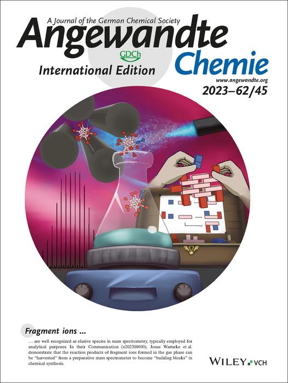Home > Press > Charged molecular beasts the basis for new compounds: Researchers at Leipzig University use aggressive fragments of molecular ions for chemical synthesis
 |
| Cover of the journal Angewandte Chemie
CREDIT Photo: Leipzig University |
Abstract:
Developing new ways to break and reform chemical bonds is one of the main tasks of basic chemical research. When a bond in a charged molecule is broken, the result is often a chemically aggressive fragment, which we call a reactive fragment. These fragments are difficult to control using established methods of chemical synthesis. You can think of them as untamed beasts that attack anything in their path. In a mass spectrometer, there are many ways to break certain bonds and generate fragments, says Dr Warneke, describing the processes in mass spectrometers. According to him, the beasts are kept under special conditions because there is a vacuum inside the mass spectrometer. This means that there is nothing for them to attack, thus preventing uncontrolled chemical reactions. If we then offer a certain molecule, for example nitrogen, which is normally unreactive and doesnt bind, the beast is satisfied with it because it has no other choice, he says. In this way, molecules that are very difficult to bind, such as nitrogen, can be easily incorporated into a new substance, Warneke continues.
Charged molecular beasts the basis for new compounds: Researchers at Leipzig University use aggressive fragments of molecular ions for chemical synthesis
Leipzig, Germany | Posted on November 3rd, 2023
In the past, the research team has used this approach to bring reactive fragments into very unusual reactions, for example, with noble gases, which are the most difficult of all chemical elements to bind. The basic strategy of controlling chemical beasts in mass spectrometers is not new, says Warneke. It has been used for decades to analyse the properties of reactive fragments. However, the new compounds found in this way could not be further used. Mass spectrometers show what is happening inside them, but the new substances are only produced in tiny quantities and cannot usually be extracted. They are often simply destroyed when the signal used for analyses is generated.
This is why researchers usually come away from experiments with mass spectrometers with great knowledge but empty hands. They have the beast under control. Exactly what they were hoping for happens, they observe the new molecule with potentially fascinating properties, and then its gone, says Warneke, describing chemical experiments in conventional mass spectrometers. The new publication could fundamentally change this view of chemical reactions in mass spectrometers. The research team produced a new substance from an aggressive fragment and unreactive nitrogen and collected it with preparative mass spectrometers in sufficient quantities so that it could be seen with the naked eye, handled and further experimented with.
The amount of substance produced by this method will remain limited to thin film technology applications for some time to come. However, preparative mass spectrometry could soon open up completely new possibilities for these applications, for example, in the production of microchips, solar cells or biologically active coatings. The junior research group has now reached an important milestone in its project, which has been funded by the Volkswagen Foundations Freigeist Fellowship since 2020.
####
For more information, please click here
Contacts:
Media Contact
Susann Sika
Leipzig University
Office: 0049-341-9735022
Expert Contact
Dr Jonas Warneke
Leipzig University
Office: +49 341 9736432
Copyright © Leipzig University
If you have a comment, please Contact us.
Issuers of news releases, not 7th Wave, Inc. or Nanotechnology Now, are solely responsible for the accuracy of the content.
![]() https://www.eurekalert.org/news-releases/1006914#:~:text=ARTICLE%20TITLE,Ed.%2045/2023):
https://www.eurekalert.org/news-releases/1006914#:~:text=ARTICLE%20TITLE,Ed.%2045/2023):
Chemistry
![]()
Ferroelectrically modulate the Fermi level of graphene oxide to enhance SERS response November 3rd, 2023
News and information
![]()
Nanoparticle quasicrystal constructed with DNA: The breakthrough opens the way for designing and building more complex structures November 3rd, 2023
Possible Futures
![]()
Light guide plate based on perovskite nanocomposites November 3rd, 2023
![]()
Study on Magnetic Force Microscopy wins 2023 Advances in Magnetism Award: Analysis of finite size effects reveals significant consequences for density measurements November 3rd, 2023
![]()
Ferroelectrically modulate the Fermi level of graphene oxide to enhance SERS response November 3rd, 2023
![]()
The USTC realizes In situ electron paramagnetic resonance spectroscopy using single nanodiamond sensors November 3rd, 2023
Chip Technology
![]()
A new qubit platform is created atom by atom October 6th, 2023
![]()
Twisted science: NIST researchers find a new quantum ruler to explore exotic matter October 6th, 2023
![]()
Successful morphing of inorganic perovskites without damaging their functional properties October 6th, 2023
Discoveries
![]()
Nanoparticle quasicrystal constructed with DNA: The breakthrough opens the way for designing and building more complex structures November 3rd, 2023
Announcements
![]()
Light guide plate based on perovskite nanocomposites November 3rd, 2023
![]()
Study on Magnetic Force Microscopy wins 2023 Advances in Magnetism Award: Analysis of finite size effects reveals significant consequences for density measurements November 3rd, 2023
![]()
Ferroelectrically modulate the Fermi level of graphene oxide to enhance SERS response November 3rd, 2023
![]()
What a 2D quantum superfluid feels like to the touch November 3rd, 2023
Interviews/Book Reviews/Essays/Reports/Podcasts/Journals/White papers/Posters
![]()
Nanoparticle quasicrystal constructed with DNA: The breakthrough opens the way for designing and building more complex structures November 3rd, 2023
Solar/Photovoltaic
![]()
The efficient perovskite cells with a structured anti-reflective layer another step towards commercialization on a wider scale October 6th, 2023
![]()
A universal HCl-assistant powder-to-powder strategy for preparing lead-free perovskites March 24th, 2023
![]()
Stability of perovskite solar cells reaches next milestone January 27th, 2023










